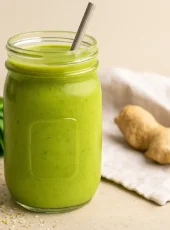The food you choose each day can either help your body fight illness or make it more vulnerable. Many people struggle with chronic inflammation, a hidden problem that can cause joint pain, fatigue, and long-term health issues. If you’re new to this approach, you can start with our Anti-Inflammatory Diet Guide to understand the basics before exploring specific spices.
Inflammation is the body’s natural way of protecting itself after injury or during illness. Short-term inflammation can speed up healing. However, when the immune system remains active for too long, it can harm tissues and increase the risk of serious conditions, such as arthritis, heart disease, and autoimmune disorders.
This article is your complete guide to using anti-inflammatory spices to support better health. You will learn about the science behind each spice, the benefits they offer, and simple ways to incorporate them into your meals. The goal is to give you clear information you can use immediately, backed by research and practical tips.
Quick Reference Table of the Top 12 Anti-Inflammatory Spices
| Spice | Active Compound | Main Benefit | Best Way to Use |
| Turmeric | Curcumin | Reduces joint pain and swelling | Add to soups, curries, or lattes |
| Ginger | Gingerol | Eases nausea and muscle soreness | Use fresh in tea or stir-fries |
| Garlic | Allicin | Supports heart health and reduces inflammation | Crush fresh into salads or sauces |
| Cinnamon | Cinnamaldehyde | Lowers blood sugar and fights inflammation | Sprinkle on oatmeal or in smoothies |
| Cayenne | Capsaicin | Improves circulation and reduces pain signals | Add a pinch to soups or marinades |
| Black Pepper | Piperine | Boosts absorption of other compounds | Grind fresh overcooked dishes |
| Rosemary | Rosmarinic acid | Protects cells from damage and reduces swelling | Use fresh in roasted vegetables |
| Green Tea | EGCG | Reduces oxidative stress and inflammation | Brew as a hot or iced drink |
| Cardamom | Cineole | Aids digestion and reduces inflammation | Add to coffee, tea, or baked goods |
| Ginseng | Ginsenosides | Supports immunity and reduces fatigue | Brew as tea or add to soups |
| Cloves | Eugenol | Eases tooth pain and supports oral health | Use whole in stews or ground in baking |
| Saffron | Crocin | Lifts mood and reduces oxidative stress | Steep in warm milk or add to rice |
What Are Anti-Inflammatory Spices?
Anti-inflammatory spices are natural seasonings that help calm the body’s immune response. They do this by reducing certain chemicals and proteins that trigger swelling, pain, and tissue damage. Many contain powerful plant compounds such as curcumin in turmeric, gingerol in ginger, and piperine in black pepper.
When eaten regularly, these spices can support joint health, improve digestion, and protect against damage from free radicals. Research shows they can lower markers of chronic inflammation like C-reactive protein and interleukin-6.
What is the Most Powerful Anti-Inflammatory Spice?
Turmeric is widely considered the most effective. Its main compound, curcumin, has been studied for its strong ability to reduce inflammation. Multiple clinical trials have shown that curcumin can help with joint pain, stiffness, and swelling in conditions such as osteoarthritis. Combining turmeric with black pepper improves absorption and makes its effects stronger.
How Quickly Do These Spices Reduce Inflammation?
The results depend on the spice, the amount used, and how often it is consumed. Some effects, like improved digestion from ginger, can appear within hours. For chronic inflammation, such as arthritis, noticeable improvement may take weeks of regular use. Consistency is more important than high doses taken occasionally.
The 12 Best Anti-Inflammatory Spices and Their Proven Benefits
1. Turmeric
How It Works: Contains curcumin, which blocks inflammatory signals in the body.
Key Benefits: Reduces joint pain, supports heart health, and protects brain function.
How to Use It: Add to curries, soups, rice dishes, or blend into golden milk. Pair with black pepper for better absorption.
Science Spotlight: A 2016 review found curcumin reduced arthritis symptoms as effectively as some anti-inflammatory drugs, without major side effects.
Want to dive deeper into this golden spice?
Explore our full guide on 15 Proven Turmeric Benefits and How to Use Them for Better Health to learn about the science behind curcumin, daily dosage tips, and delicious ways to enjoy turmeric every day.
2. Ginger
How It Works: Contains gingerol, which reduces inflammation and oxidative stress.
Key Benefits: Helps with muscle soreness, menstrual pain, and digestion.
How to Use It: Slice fresh ginger for tea, grate it into stir-fries, or add it to smoothies.
Science Spotlight: A 2015 study showed ginger supplementation lowered inflammatory markers in people with type 2 diabetes.
3. Garlic
How It Works: Rich in allicin, which can reduce the activity of inflammatory enzymes.
Key Benefits: Supports immune function, heart health, and reduces joint stiffness.
How to Use It: Crush fresh cloves and mix into salads, dressings, or cooked vegetables.
Science Spotlight: Research from 2018 found that garlic supplements improved symptoms in people with osteoarthritis of the knee.
4. Cinnamon
How It Works: Contains cinnamaldehyde, which reduces inflammation and helps control blood sugar.
Key Benefits: Supports metabolic health and protects against oxidative stress.
How to Use It: Sprinkle on oatmeal, coffee, yogurt, or in baked goods.
Science Spotlight: Studies show that cinnamon can lower C-reactive protein, a key marker of inflammation.
5. Cayenne Pepper
How It Works: Contains capsaicin, which blocks pain signals and reduces inflammatory responses.
Key Benefits: Eases nerve pain, boosts circulation, and supports metabolism.
How to Use It: Add a pinch to soups, stews, marinades, or homemade sauces.
Science Spotlight: Clinical research shows topical capsaicin creams can reduce arthritis pain.
6. Black Pepper
How It Works: Contains piperine, which can reduce inflammation and improve nutrient absorption.
Key Benefits: Enhances the effects of other anti-inflammatory compounds, supports digestion.
How to Use It: Grind fresh over savory dishes, soups, and roasted vegetables.
Science Spotlight: Piperine has been shown to increase curcumin absorption by up to 2000 percent.
7. Rosemary
How It Works: Contains rosmarinic acid, which has anti-inflammatory and antioxidant effects.
Key Benefits: Supports memory, digestion, and joint comfort.
How to Use It: Add fresh or dried rosemary to roasted vegetables, poultry, or bread.
Science Spotlight: Animal studies suggest rosmarinic acid reduces inflammation in joint tissues.
8. Green Tea
How It Works: Contains EGCG, a compound that reduces oxidative stress and inflammation.
Key Benefits: Supports heart health, brain function, and weight management.
How to Use It: Brew as a hot drink or make iced green tea. Avoid over-steeping to prevent bitterness.
Science Spotlight: Regular consumption has been linked to lower levels of C-reactive protein.
9. Cardamom
How It Works: Contains cineole, which helps relax muscles and reduce inflammation.
Key Benefits: Improves digestion, supports oral health, and may help with blood pressure control.
How to Use It: Add to tea, coffee, curries, and baked goods.
Science Spotlight: A study in people with high blood pressure found that daily cardamom lowered blood pressure and improved antioxidant status.
10. Ginseng
How It Works: Contains ginsenosides, which regulate immune responses and reduce inflammation.
Key Benefits: Boosts energy, supports immunity, and reduces fatigue.
How to Use It: Brew dried slices in tea or add to soups.
Science Spotlight: Clinical trials show ginseng can reduce markers of inflammation in chronic illnesses.
11. Cloves
How It Works: Contains eugenol, a compound with strong anti-inflammatory and pain-relieving effects.
Key Benefits: Supports oral health, digestion, and antioxidant protection.
How to Use It: Add whole cloves to stews or use ground cloves in baking.
Science Spotlight: Eugenol has been shown to reduce inflammation in gum disease.
12. Saffron
How It Works: Contains crocin, which protects cells from oxidative damage and reduces inflammation.
Key Benefits: Lifts mood, supports memory, and improves vision health.
How to Use It: Steep threads in warm milk or add to rice and seafood dishes.
Science Spotlight: Human studies suggest saffron may reduce depression symptoms while lowering inflammation markers.
How to Incorporate Anti-Inflammatory Spices into Your Diet
Spice Blends
Mixing several spices creates a flavor-rich blend that boosts the anti-inflammatory effects. A homemade mix can be sprinkled on roasted vegetables, added to soups, or stirred into dressings. You can create a blend using turmeric, ginger, cinnamon, cayenne, and black pepper for an easy all-purpose seasoning.
Cooking Tips
- Pair Spices with Healthy Fats: Curcumin in turmeric and other compounds absorb better with fats like olive oil or coconut milk.
- Use Fresh Spices When Possible: Fresh ginger, garlic, and herbs often have stronger active compounds than dried versions.
- Add at the Right Time: Some compounds are sensitive to heat. Add spices like green tea or saffron toward the end of cooking to preserve their benefits.
- Experiment with Combinations: Turmeric with black pepper, cinnamon with ginger, and rosemary with garlic are flavorful and scientifically supported pairings.
Common Mistakes to Avoid

1. Overusing Certain Spices
Some spices can cause side effects if taken in large amounts. For example, too much cinnamon, especially Cassia cinnamon, can lead to excess coumarin intake, which may harm the liver.
2. Ignoring Freshness
Spices lose their strength over time. Old jars stored for years often have fewer active compounds. Replace ground spices every 6 to 12 months and store them in airtight containers away from heat and light.
3. Adding Spices Too Early in Cooking
Some beneficial compounds are sensitive to high heat. For example, green tea loses antioxidants if steeped in boiling water for too long. Add delicate spices near the end of cooking to protect their health properties.
4. Skipping Food Pairings
Certain compounds work better together. For example, pairing turmeric with black pepper can increase curcumin absorption significantly. Missing these pairings can reduce the benefits you get.
5. Relying Only on Spices for Health
Spices are a powerful addition to a healthy lifestyle, but they work best alongside a balanced diet, regular activity, and good sleep habits.
Everyday Meal Integration
You can combine these daily spice ideas with the foods from our Anti-Inflammatory Grocery List to create flavorful, health-supporting meals. Here are some examples:
Breakfast
- Sprinkle cinnamon on oatmeal with berries.
- Add turmeric and black pepper to scrambled eggs.
- Brew green tea for a morning antioxidant boost.
Lunch
- Use a garlic and rosemary marinade for grilled chicken or vegetables.
- Add fresh ginger to a vegetable stir-fry.
- Include cayenne in homemade hummus for a mild kick.
Snack
- Drink ginger tea with lemon.
- Enjoy yogurt with cardamom and a drizzle of honey.
- Have a small handful of nuts dusted with turmeric and salt.
Dinner
- Add saffron to a rice side dish.
- Season roasted vegetables with a turmeric-ginger blend.
- Use cloves and cinnamon in a hearty stew.
Evening Treat
- Prepare golden milk with turmeric, cinnamon, and black pepper.
- Add a pinch of cardamom to hot cocoa for a warm, spiced flavor.
The Bottom Line
Adding anti-inflammatory spices to your meals is an easy way to support long-term health. These natural seasonings contain plant compounds that can reduce swelling, protect cells from damage, and improve overall well-being. Regular use, combined with a balanced diet and healthy lifestyle habits, can help manage symptoms linked to chronic inflammation, such as joint pain and digestive discomfort.
Safety Tips and Health Disclaimer
While these spices offer proven benefits, they are not a substitute for medical treatment. People with ongoing health conditions or those taking medication should speak with a healthcare professional before making major dietary changes or taking supplements.
Some spices can cause side effects in large amounts. For example, Cassia cinnamon contains coumarin, which may be harmful to the liver when consumed in excess. Pregnant or breastfeeding individuals should also check with their doctor before increasing spice intake beyond normal food amounts.
Expert Opinions and Scientific References
Registered Dietitian Insight:
“Incorporating a variety of anti-inflammatory spices into your diet is a simple way to add both flavor and health benefits,” says Dr. Laura Mitchell, RD. “Turmeric, ginger, and cinnamon have some of the most consistent research supporting their role in lowering inflammation markers, but the key is regular use in small, balanced amounts.”
Medical Perspective:
“These spices work best as part of a broader healthy lifestyle that includes plenty of vegetables, whole grains, and lean protein,” explains Dr. James Lee, MD, an internal medicine specialist. “While they can be helpful, they should not replace prescribed treatments for chronic conditions.”
References
- Hewlings, S. J., & Kalman, D. S. (2017). Curcumin: A review of its effects on human health. Foods, 6(10), 92.
- Arablou, T., & Aryaeian, N. (2018). The effect of ginger on glycemic markers: A systematic review and meta-analysis. Nutrition, 51–52, 7–13.
- Ranasinghe, P., et al. (2012). Cinnamon in diabetes mellitus: A systematic review and meta-analysis. Diabetic Medicine, 34(11), 1480–1492.
- Chueh, T., et al. (2015). Anti-inflammatory effects of rosemary extract. Journal of Medicinal Food, 18(3), 290–298.
- Pan, M. H., et al. (2000). Piperine and the bioavailability of curcumin. Planta Medica, 66(2), 118–122.







